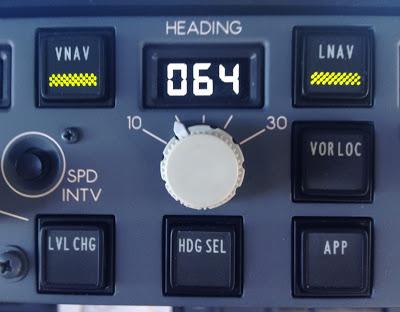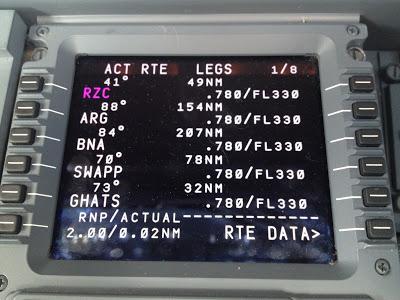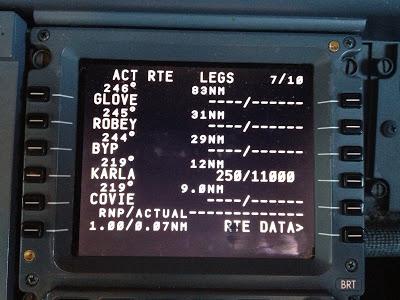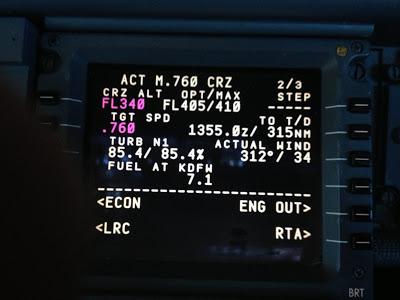As a side note, I’m reminded of a ground school instructor I once had who walked into what was supposed to be the pump up day before an oral exam and asked...with a straight face I might add "what don't you know?" I have no idea what I don't know! What kind of question is that? I felt like I knew everything the day I cleared the last hurdle in my 737 training, but there is plenty left to learn.
This week's learning opportunity came compliments of a Ft. Worth Center Air Traffic Controller attempting to fit me into a long line of arrivals and a pesky little button marked VNAV.

Most airplanes will track a lateral course and some will track a vertical path as well...this is all done via two buttons, one marked LNAV and one marked VNAV, the definitions of which should be obvious. You can make the airplane fly directly to just about anything...VOR, ADF, intersection, airport or even a specific lat/long point. Simply put the point on top of the LEGS page, activate, execute and select LNAV. It's simple and hard to screw up. As long as the autopilot is engaged...sit back and watch it work.

Direct RZC (Razor Back VOR).
While simple on the surface, VNAV has a tendency to get slightly more confusing. "Flight 123, cross the KARLA intersection at 11,000 and 250 knots.” All you have to do is plug that information into "the box," press VNAV and watch the magic happen. That's the way it's supposed to happen, but there are almost always factors in play to complicate what should be a simple procedure. I'll get back to descents in a moment.
Set up to cross KARLA at 250 knots and 11,000 feet.
VNAV Climb...VNAV climb works quite well and is generally straight forward and easy to use. Actually it's one of my favorite things about the 737. By contrast, an MD80 pilot, whether hand flying or utilizing the auto pilot, has a laundry list of things to do in order to make his jet track the proper course and climb at the desired speed. After manually engaging NAV at 400 feet (similar to LNAV on a 737) the pilot continues to climb until reaching 1,000 feet at which point he will reduce the rate of climb, set climb power on the engines, retract the flaps and accelerate at around 1,500 feet per minute until reaching the desired climb speed of 250 knots (that’s the speed limit below 10,000). Once at the desired speed he will select IAS (Indicated Air Speed) and continue the climb to 10,000 feet. Once above 10,000 there's more work to do. The pilot will use any one of several ways to accelerate the airplane to a cruise climb speed of around 300-310 knots and manually transition to Mach somewhere in the upper 20's. It's as confusing as it sounds, but it becomes second nature over time.
On the 737, LNAV automatically engages as the jet climbs through 50 feet and the pilot simply pushes VNAV at 1,000 feet...other than manually retracting the gear and flaps, the airplane does the rest.
VNAV Cruise...
VNAV cruise is also simple and hard to mess up. The airplane automatically enters VNAV PATH once it reaches cruises altitude...nothing to remember...no buttons to push. If you want or need to climb or descend to another cruise altitude, simply put the new altitude on the cruise page of the FMS and the airplane will climb or descend on its own. Simple.

Set to cruise at FL340 (34,000 ft.)
VNAV Descent...VNAV descent is where things have a tendency to get tricky. The MD80 was a simple minded creature with the added assistance of a pretty good GPS based FMS. One of the things I liked about that airplane was the fact that the FMS displayed the required vertical speed needed to achieve any crossing restriction. All the pilot had to do was match the V/S with the number provided by the box and monitor the progress.
For an airplane equipped with VNAV, the process of getting down is easy enough as long as everything goes as planned...unfortunately, it rarely does. The FMS knows the cruise altitude and the pilot inputs crossing altitudes and speeds onto the LEGS page of the FMS if that data wasn't automatically included as part of an arrival procedure. If he's smart, the pilot will also go to the FORECAST section of the DESCENT page and input predictions for wind speed, the use of anti-ice (this increases power on the engines and the time needed to descend) and even the altimeter setting at the destination. This information will help the FMS to make adjustments to the top of descent (TOD) and will result in a more accurately planned descent.
Here’s the problem…
The airplane wants to fly the most economical descent possible and that usually means a power off descent. Once the jet reaches the TOD, the power is reduced to idle and the airplane pitches to maintain the planned speed. If ATC waits until after the TOD to issue a slower than planned descent speed, then the only way to make the crossing restriction is to add drag...which reminds me of an old fabled story (that probably never happened) about an air traffic controller who issued a descent clearance to which the pilot was unable to comply. "Unable," the pilot advised, "we're too high." The controller reportedly responded "but don't you have speed brakes?" The pilot answered “yes, but speed brakes are for my mistakes, not yours." I would strongly advise NOT using that one in real life unless you have a desire to practice your holding skills.
That scenario could happen to any airplane regardless of whether it had VNAV capability. The real problem is that once you start making changes to the planned descent profile, the airplane has a tendency to get confused and may or may not make the altitude restrictions.
As I mentioned before, I had a little lesson on the subject just this week. We were flying the BONHAM 5 (BYP5) arrival to DFW and were last in a long line of inbound aircraft. About a hundred miles from the TOD, I checked the altitude and speed restrictions on the arrival, entered the forecast wind data and watched the TOD moved in response to the information I entered into the FMS. I won't bore you with all the details, but we were given a series of descent clearances, told to slow to 250 knots, turned off course...three times...then cleared direct to a point on the arrival and told to maintain our best forward speed.
The end result was a thoroughly confused FMS that I eventually had to abandon altogether. It's always a good idea to back up the FMS by performing the descent math in your head. Otherwise you won't know the magic box is failing you.
I eventually reverted to LVL CHG, a button on the mode control panel that basically does the same thing as the IAS button on the MD80. With the added assistance of the flight spoilers and the extra speed ATC desired, I was able to get the airplane down and on speed just in time to meet the restrictions on the arrival. The FMS was no help at all and if I had relied on it, we would have violated the descent clearance.
So while they taught me how to use VNAV in school, there's definitely some finesse and a few techniques to make the system work at its best. I learned a few of those this week My inexperience most likely compounded the issues forced upon me by FTW Center, but in the end I got the job done safely and I doubt anyone in the back new I was struggling.
The lesson learned? Check and recheck the box. Do the math in your head and if the box fails you…be prepared to intervene.
